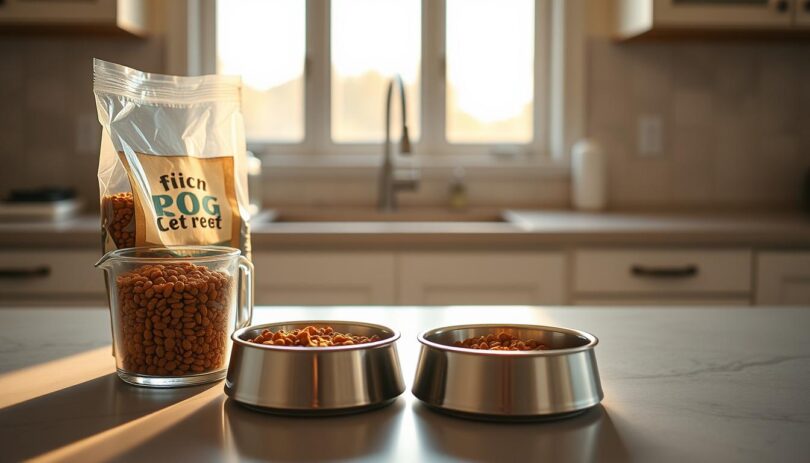Did you know 64% of pet owners switch their dog’s diet without proper guidance, often leading to vomiting or diarrhea? This startling statistic highlights why changing meals requires more than swapping kibble brands overnight. A gradual approach isn’t just helpful—it’s essential for keeping tails wagging and stomachs settled.
Veterinarians stress that even prescription diets need careful integration. Mixing old and new formulas over 5-7 days helps sensitive digestive systems adapt. Starting with 25% fresh ingredients blended into familiar meals reduces risks like loose stools or appetite loss.
Every pup reacts differently. Observing energy levels, coat condition, and bathroom habits during the process helps spot problems early. Dogs with food sensitivities might need slower adjustments, while others adapt quickly—but patience remains key for all.
This guide simplifies the switch with science-backed steps tailored to your pet’s needs. Discover how to balance nutrients, track progress, and collaborate with your vet for optimal results. Let’s create a stress-free experience that keeps your furry friend thriving.
Understanding the Importance of a Gradual Diet Change
Canine digestive systems thrive on routine—abrupt food swaps disrupt gut bacteria in 80% of dogs within two days. This microbial imbalance often triggers vomiting, loose stools, or appetite loss. A phased approach gives digestive enzymes and intestinal flora time to adapt, reducing stress on your pet’s system.
Spotting Digestive Red Flags
Watch for these signs during dietary adjustments:
- Unformed stools or increased bathroom trips
- Regurgitation within an hour of eating
- Reduced interest in meals lasting over 24 hours
Veterinarians recommend using a fecal scoring chart—tracking consistency from firm logs to watery puddles—to catch issues early. If scores dip below ideal ranges, slow the transition.
The Science Behind Mixing Ratios
Most dogs adapt best with this 7-day plan:
| Days | Old Food | New Food |
|---|---|---|
| 1-2 | 75% | 25% |
| 3-4 | 50% | 50% |
| 5-7 | 25% | 75% |
Sensitive pups might need 10-14 days. Persistent diarrhea or vomiting? Contact your vet immediately—these could signal food intolerance or underlying conditions needing professional care.
Preparing for a New Diet: Steps Before the Food Switch
Smart preparation lays the foundation for dietary success. Before altering meals, pet parents need two critical insights: their dog’s nutritional baseline and professional health recommendations.
Assessing Your Dog’s Current Diet and Preferences
Start by examining ingredient lists on your pet’s current food. Note protein sources, fiber content, and additives. Dogs with grain sensitivities often thrive on limited-ingredient diets, while others may need adjusted fat levels.
Track meal times and portion sizes for three days. Observe which textures or flavors your companion prefers—some pets avoid wet food but devour kibble. This data helps select a nutritionally similar replacement.
Consulting Your Veterinarian for Tailored Guidance
Schedule a vet visit to review your findings. Professionals analyze age, weight, and health history to recommend suitable diets. For example, senior dogs might need joint-supporting nutrients absent in puppy formulas.
Share any past reactions like itching or stomach upset. Vets often suggest allergy tests or gradual introduction plans for sensitive pets. They may also prescribe probiotics to ease digestion during the change.
Armed with this knowledge, owners can confidently choose a diet that aligns with their dog’s needs while minimizing risks.
How to transition your dog to a new food
Successful dietary shifts require precision and attentiveness. A structured plan minimizes digestive surprises while helping pets adapt to nutritional changes. Let’s explore proven methods for introducing different meals effectively.
Step-by-Step Gradual Transition Process
Follow this seven-day framework to blend meals smoothly:
| Days | Current Food | New Formula | Action |
|---|---|---|---|
| 1-2 | 75% | 25% | Mix thoroughly |
| 3-4 | 50% | 50% | Observe stool consistency |
| 5-7 | 25% | 75% | Adjust portions if needed |
Measure meals precisely using a kitchen scale or measuring cup. Serve at consistent times to maintain routine. Track appetite and energy levels daily—hesitation to eat may signal discomfort.
Adjusting Ratios for Sensitive Stomachs
Pets with delicate digestion often need extended timelines. Stretch the process to 10-14 days, increasing new formula by 10% every two days instead of 25%. Watch for:
- Loose stools lasting more than 24 hours
- Excessive gas or bloating
- Repeated vomiting episodes
If these occur, revert to the previous ratio for three days before advancing. For persistent diarrhea, consult your veterinarian—they might recommend digestive enzymes or specialized probiotics.
Remember: Each pet’s tolerance varies. Some thrive within a week, while others need month-long adjustments. Patience ensures long-term dietary success.
Quick Switch Scenarios and Emergency Diet Changes
Emergencies like food recalls or allergic reactions sometimes demand immediate dietary shifts. While gradual transitions are ideal, 18% of pet owners face urgent situations requiring rapid changes. Safety remains paramount—even under pressure.
When a Rapid Change Is Necessary
Three scenarios justify swift food swaps:
- Product recalls affecting current dog food
- Severe allergic reactions causing swelling or hives
- Complete refusal to eat for over 48 hours
Puppies and pets with chronic conditions shouldn’t use this method unless directed by a veterinarian. Always keep a 3-day supply of backup meals for emergencies.
Tips for Handling a Quick Transition Safely
Follow this condensed timeline if urgency strikes:
| Time Frame | New Food % | Monitoring Focus |
|---|---|---|
| Day 1 | 30% | Appetite, energy levels |
| Day 2 | 60% | Stool consistency, vomiting |
| Day 3 | 100% | Overall behavior changes |
Add low-sodium broth or plain pumpkin to boost acceptance of unfamiliar foods. If diarrhea or vomiting persists beyond 12 hours, revert to the previous diet and contact your vet immediately. Store emergency kits with vet-approved probiotics to support gut health during abrupt changes.
Track water intake closely—dehydration risks spike during rapid transitions. Document all symptoms with photos or notes to share with your veterinarian if concerns arise. While stressful, calm handling helps pets adapt better to sudden dietary shifts.
Final Advice and Monitoring for a Successful Transition
A smooth diet transition hinges on observation and patience, ensuring your dog’s health remains a priority. Gradual mixing over 7-14 days allows digestive systems to adapt while reducing stomach upset. Track progress using tools like fecal charts and daily behavior notes—these reveal subtle changes before they become serious.
Watch for bright eyes, firm stools, and consistent energy levels as signs of success. If loose stools or low appetite last beyond three days, pause the process and consult your veterinarian. They can identify food sensitivities or recommend supplements to ease discomfort.
After completing the switch, maintain regular health checks. Weigh your pet monthly and assess their coat condition. Keep portion sizes consistent with their activity level and age requirements.
Remember: Every dog adapts differently. Use this guide as a starting point, but always prioritize professional advice for unique needs. With careful monitoring and timely adjustments, your companion will thrive on their new diet while enjoying meals that support lifelong wellness.
FAQ
Why do dogs need a gradual diet transition?
A slow switch helps prevent gastrointestinal issues like diarrhea or vomiting. Sudden changes disrupt gut bacteria, which can stress a dog’s digestive system. Most pets adapt better when given 7–10 days to adjust to new ingredients.
When should I consult a vet before changing foods?
Always talk to your veterinarian if your pet has chronic health conditions, food allergies, or a history of stomach sensitivity. Brands like Hill’s Science Diet or Royal Canin may require specific transition plans for therapeutic formulas.
How long does a typical food transition take?
Most dogs adapt well to a 7-day plan, mixing increasing amounts of new food with their current diet. For sensitive breeds like French Bulldogs or German Shepherds, extend the process to 10–14 days to minimize digestive upset.










Leave a Comment